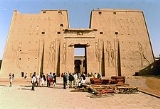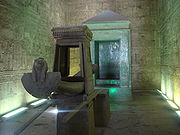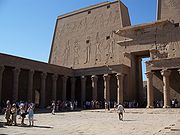
Temple of Edfu
Encyclopedia
| Temple of Edfu | |
| Monument information | |
|---|---|
| Type | Temple Temple A temple is a structure reserved for religious or spiritual activities, such as prayer and sacrifice, or analogous rites. A templum constituted a sacred precinct as defined by a priest, or augur. It has the same root as the word "template," a plan in preparation of the building that was marked out... |
| Location | Egypt Egypt Egypt , officially the Arab Republic of Egypt, Arabic: , is a country mainly in North Africa, with the Sinai Peninsula forming a land bridge in Southwest Asia. Egypt is thus a transcontinental country, and a major power in Africa, the Mediterranean Basin, the Middle East and the Muslim world... |
| Nome Nome (Egypt) A nome was a subnational administrative division of ancient Egypt. Today's use of the Greek nome rather than the Egyptian term sepat came about during the Ptolemaic period. Fascinated with Egypt, Greeks created many historical records about the country... Upper Egypt Upper Egypt Upper Egypt is the strip of land, on both sides of the Nile valley, that extends from the cataract boundaries of modern-day Aswan north to the area between El-Ayait and Zawyet Dahshur . The northern section of Upper Egypt, between El-Ayait and Sohag is sometimes known as Middle Egypt... |
|
| Hieroglyphic name Egyptian hieroglyphs Egyptian hieroglyphs were a formal writing system used by the ancient Egyptians that combined logographic and alphabetic elements. Egyptians used cursive hieroglyphs for religious literature on papyrus and wood... (Bḥd.t) |
|
| Deity Horus Horus Horus is one of the oldest and most significant deities in the Ancient Egyptian religion, who was worshipped from at least the late Predynastic period through to Greco-Roman times. Different forms of Horus are recorded in history and these are treated as distinct gods by Egyptologists... (primary), Hathor Hathor Hathor , is an Ancient Egyptian goddess who personified the principles of love, beauty, music, motherhood and joy. She was one of the most important and popular deities throughout the history of Ancient Egypt... , Harsomtus |
|
| Historical information | |
| Period | Graeco-Roman Period |
| Dynasty | Ptolemaic Dynasty Ptolemaic dynasty The Ptolemaic dynasty, was a Macedonian Greek royal family which ruled the Ptolemaic Empire in Egypt during the Hellenistic period. Their rule lasted for 275 years, from 305 BC to 30 BC... |
| Construction Start Date August 23, 237 BCE |
|
| Completion Date 57 BCE |
|
| colspan="2" style="background-color: #d5a474; text-align: center;" Architectural description | |
| Construction material Sandstone Sandstone Sandstone is a sedimentary rock composed mainly of sand-sized minerals or rock grains.Most sandstone is composed of quartz and/or feldspar because these are the most common minerals in the Earth's crust. Like sand, sandstone may be any colour, but the most common colours are tan, brown, yellow,... |
|
| Height 36 metres |
|
| Width 36 metres |
|
| Length 79 metres |
|
The Temple of Edfu is an ancient Egypt
Ancient Egypt
Ancient Egypt was an ancient civilization of Northeastern Africa, concentrated along the lower reaches of the Nile River in what is now the modern country of Egypt. Egyptian civilization coalesced around 3150 BC with the political unification of Upper and Lower Egypt under the first pharaoh...
ian temple
Egyptian temple
Egyptian temples were built for the official worship of the gods and commemoration of pharaohs in Ancient Egypt and in regions under Egyptian control. These temples were seen as houses for the gods or kings to whom they were dedicated...
located on the west bank of the Nile
Nile
The Nile is a major north-flowing river in North Africa, generally regarded as the longest river in the world. It is long. It runs through the ten countries of Sudan, South Sudan, Burundi, Rwanda, Democratic Republic of the Congo, Tanzania, Kenya, Ethiopia, Uganda and Egypt.The Nile has two major...
in the city of Edfu
Edfu
Edfu is an Egyptian city, located on the west bank of the Nile River between Esna and Aswan, with a population of approximately sixty thousand people. For the ancient history of the city, see below...
which was known in Greco-Roman times as Apollonopolis Magna, after the chief god Horus-Apollo. It is one of the best preserved temples in Egypt. The temple, dedicated to the falcon god Horus
Horus
Horus is one of the oldest and most significant deities in the Ancient Egyptian religion, who was worshipped from at least the late Predynastic period through to Greco-Roman times. Different forms of Horus are recorded in history and these are treated as distinct gods by Egyptologists...
, was built in the Ptolemaic period between 237 and 57 BCE. The inscriptions on its walls provide important information on language, myth and religion during the Greco-Roman period in ancient Egypt. In particular, the Temple's inscribed building texts "provide details [both] of its construction, and also preserve information about the mythical interpretation of this and all other temples as the Island of Creation." There are also "important scenes and inscriptions of the Sacred Drama which related the age-old conflict between Horus and Seth." They are translated by the German Edfu-Project
Edfu-Project
The Edfu project is being undertaken with the primary goal of translations of inscriptions of an ancient temple of Edfu.-History:In 1986, Professor Dr...
.
History
Edfu was one of several temples built during the Ptolemaic period, including DenderaDendera Temple complex
Dendera Temple complex, . located about 2.5 km south-east of Dendera, Egypt. It is one of the best-preserved temple complexes in Egypt...
, Esna
Esna
Esna , known to the ancient Egyptians as Egyptian: Iunyt or Ta-senet; Greek: or or ; Latin: Lato, is a city in Egypt. It is located on the west bank of the River Nile, some 55 km south of Luxor...
, Kom Ombo
Temple of Kom Ombo
The Temple of Kom Ombo is an unusual double temple built during the Ptolemaic dynasty in the Egyptian town of Kom Ombo. Some additions to it were later made during the Roman period. The building is unique because its 'double' design meant that there were courts, halls, sanctuaries and rooms...
and Philae
Philae
Philae is an island in the Nile River and the previous site of an Ancient Egyptian temple complex in southern Egypt...
. Its size reflects the relative prosperity of the time. The present temple, which was begun "on 23 August 237 BCE, initially consisted of a pillared hall, two transverse halls, and a barque sanctuary surrounded by chapels." The building was started during the reign of Ptolemy III and completed in 57 BCE under Ptolemy XII. It was built on the site of an earlier, smaller temple also dedicated to Horus, although the previous structure was oriented east-west rather than north-south as in the present site. A ruined pylon
Pylon (architecture)
Pylon is the Greek term for a monumental gateway of an Egyptian temple It consists of two tapering towers, each surmounted by a cornice, joined by a less elevated section which enclosed the entrance between them. The entrance was generally about half the height of the towers...
lies just to the east of the current temple; inscriptional evidence has been found indicating a building program under the New Kingdom
New Kingdom
The New Kingdom of Egypt, also referred to as the Egyptian Empire is the period in ancient Egyptian history between the 16th century BC and the 11th century BC, covering the Eighteenth, Nineteenth, and Twentieth Dynasties of Egypt....
rulers Ramesses I
Ramesses I
Menpehtyre Ramesses I was the founding Pharaoh of Ancient Egypt's 19th dynasty. The dates for his short reign are not completely known but the time-line of late 1292-1290 BC is frequently cited as well as 1295-1294 BC...
, Seti I
Seti I
Menmaatre Seti I was a Pharaoh of Ancient Egypt , the son of Ramesses I and Queen Sitre, and the father of Ramesses II...
and Ramesses II
Ramesses II
Ramesses II , referred to as Ramesses the Great, was the third Egyptian pharaoh of the Nineteenth dynasty. He is often regarded as the greatest, most celebrated, and most powerful pharaoh of the Egyptian Empire...
.


Nectanebo II
Nectanebo II was the third and last pharaoh of the Thirtieth dynasty, as well as the last native ruler of Ancient Egypt. Under Nectanebo II Egypt prospered...
, a relic from an earlier building, is preserved in the inner sanctuary, which stands alone while the temple's barque sanctuary is surrounded by nine chapels.
The temple of Edfu fell into disuse as a religious monument following Theodosius I
Theodosius I
Theodosius I , also known as Theodosius the Great, was Roman Emperor from 379 to 395. Theodosius was the last emperor to rule over both the eastern and the western halves of the Roman Empire. During his reign, the Goths secured control of Illyricum after the Gothic War, establishing their homeland...
's edict banning non-Christian worship within the Roman Empire
Roman Empire
The Roman Empire was the post-Republican period of the ancient Roman civilization, characterised by an autocratic form of government and large territorial holdings in Europe and around the Mediterranean....
in 391 CE. As elsewhere, many of the temple's carved reliefs were razed by followers of the Christian faith which came to dominate Egypt. The blackened ceiling of the hypostyle
Hypostyle
In architecture, a hypostyle hall has a roof which is supported by columns, as in the Great Hypostyle Hall at Karnak. The word hypostyle comes from the Ancient Greek hypóstȳlos meaning "under columns"...
hall, visible today, is believed to be the result of arson intended to destroy religious imagery that was then considered pagan.
Over the centuries, the temple became buried to a depth of 12 metres (39 ft) beneath drifting desert sand and layers of river silt deposited by the Nile. Local inhabitants built homes directly over the former temple grounds. Only the upper reaches of the temple pylons were visible by 1798, when the temple was identified by a French expedition. In 1860 Auguste Mariette
Auguste Mariette
François Auguste Ferdinand Mariette was a French scholar, archaeologist and Egyptologist, the designer of the rebuilt Egyptian Museum under Maximilian of Austria orders when the later had gained control of the artifacts collected to that point.-Early career:Born at Boulogne-sur-Mer, Mariette...
, a French Egyptologist, began the work of freeing Edfu temple from the sands.
The Temple of Edfu is nearly intact and a very good example of an ancient Egyptian temple. The Temple of Edfu's archaeological significance and high state of preservation has made it a centre for tourism in Egypt
Tourism in Egypt
Tourism is one of the most important sectors in Egypt's economy. More than 12.8 million tourists visited Egypt in 2008, providing revenues of nearly $11 billion. The sector employs about 12 percent of Egypt's workforce. -History:...
and a frequent stop for the many riverboat
Riverboat
A riverboat is a ship built boat designed for inland navigation on lakes, rivers, and artificial waterways. They are generally equipped and outfitted as work boats in one of the carrying trades, for freight or people transport, including luxury units constructed for entertainment enterprises, such...
s that cruise the Nile. In 2005, access to the temple was revamped with the addition of a visitor center and paved carpark. A sophisticated lighting system was added in late 2006 to allow night visits.
Religious significance
The temple of Edfu is the largest temple dedicated to Horus and Hathor of Dendera. It was the center of several festivals sacred to Horus. Each year, "Hathor travelled south from her temple at DenderahDendera Temple complex
Dendera Temple complex, . located about 2.5 km south-east of Dendera, Egypt. It is one of the best-preserved temple complexes in Egypt...
to visit Horus at Edfu, and this event marking their sacred marriage was the occasion of a great festival and pilgrimage."
Influence on British Architecture
The Temple of Edfu provides the model for Temple WorksTemple Works
Temple Works is a former flax mill in Holbeck, Leeds, West Yorkshire, England. It was designed by Joseph Bonomi the Younger and built by John Marshall between 1836 and 1840. Temple Works is the only Grade I listed building in Holbeck....
in Holbeck
Holbeck
Holbeck is a district in Leeds, West Yorkshire, England.The district begins on the southern edge of the Leeds city centre and mainly lies in the LS11 Leeds postcode area. The M1 and M621 motorways used to end/begin in Holbeck. Now the M621 is the only motorway that passes through the area since...
, Leeds
Leeds
Leeds is a city and metropolitan borough in West Yorkshire, England. In 2001 Leeds' main urban subdivision had a population of 443,247, while the entire city has a population of 798,800 , making it the 30th-most populous city in the European Union.Leeds is the cultural, financial and commercial...
. The courtyard columns at Edfu are closely copied in the frontage of the leeds building.
See also
- EdfuEdfuEdfu is an Egyptian city, located on the west bank of the Nile River between Esna and Aswan, with a population of approximately sixty thousand people. For the ancient history of the city, see below...
- Dendera Temple complexDendera Temple complexDendera Temple complex, . located about 2.5 km south-east of Dendera, Egypt. It is one of the best-preserved temple complexes in Egypt...
- Ancient Egyptian architectureAncient Egyptian architectureThe Nile valley has been the site of one of the most influential civilizations which developed a vast array of diverse structures encompassing ancient Egyptian architecture...
General references
- Oakes, Lorna and Lucia Gahlin. Ancient Egypt: An illustrated reference to the myths, religions, pyramids and temples of the land of the pharaohs. 2006. ISBN 0-7607-4943-4

